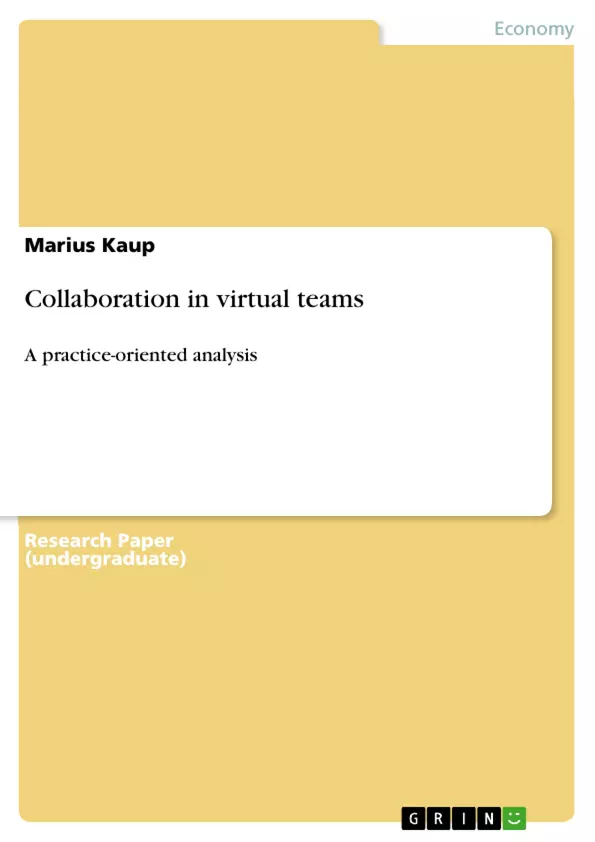The change from traditional teamwork, with team members facing each other face to face in a room, to virtual collaborations, with members working over distance and time, is a phenomenon often mentioned and extensively addressed in specialist literature.
More than 10 years ago, Deborah L. Duarte and Nancy Tennant Snyder noted that newly developed communication technologies at the time and increasing globalization, which radicalized networking among companies, created the basis for virtual teamwork.
More current works show that virtual teams have now become indispensable in almost every company. In 2013, for example, Sonja App even speaks of a revolution in the world of work, which, brought about by the newly emerged media, has created new forms of collaboration.
The structure of this paper entitled "Collaboration in virtual teams - a practical analysis" can be divided into three parts. It begins with two theoretical sections that form the basis for the practical analysis found in the third part.
Inhaltsverzeichnis (Table of Contents)
- Introduction
- Basics about virtual teams
- Definition
- From traditional to virtual teams
- Features of virtual teams
- Types of virtual teams
- Collaboration in virtual teams
- Formation and leadership of virtual teams
- Communication
- Challenges
- Technology use
- Opportunities/Benefits
- Personal level
- Organizational level
- Social level
- Difficulties/disadvantages
- Practice-oriented analysis
- RedQuadrant Ltd
- Presentation of the company
- Virtual teamwork at RedQuadrant
- Case study on virtual teamwork
- RedQuadrant Ltd
Zielsetzung und Themenschwerpunkte (Objectives and Key Themes)
This work, entitled "Collaboration in virtual teams - a practice-oriented analysis," examines the transition from traditional to virtual teamwork, exploring its characteristics, benefits, and challenges. It aims to provide a comprehensive overview of virtual teamwork, using both theoretical frameworks and practical examples.
- Defining and distinguishing virtual teams from traditional teams
- Analyzing the role of communication and technology in virtual collaboration
- Exploring the opportunities and difficulties associated with virtual teamwork
- Presenting practical examples of virtual teamwork in real-world companies
- Examining the impact of virtual teams on individuals, organizations, and society
Zusammenfassung der Kapitel (Chapter Summaries)
- Introduction: This chapter sets the stage for the work, highlighting the growing importance of virtual teams due to globalization and technological advancements. It provides an overview of the work's structure and discusses the transition from traditional teamwork to virtual collaboration.
- Basics about virtual teams: This chapter defines virtual teams, comparing them to traditional teams and outlining key characteristics such as spatial distance and reliance on technology. It concludes with an overview of different types of virtual teams.
- Collaboration in virtual teams: This chapter focuses on the specifics of virtual collaboration, exploring the formation and leadership of virtual teams, particularly addressing communication challenges and the role of technology. It examines both the opportunities and difficulties associated with this form of teamwork, considering its impact on individuals, organizations, and society.
- Practice-oriented analysis: This chapter delves into real-world examples of virtual teamwork. It starts with a presentation of virtual teamwork at RedQuadrant Ltd, a consulting firm. It then further explores virtual teamwork through a case study, examining practical features and effects of virtual cooperation.
Schlüsselwörter (Keywords)
This work focuses on key concepts such as virtual teams, traditional teams, communication, technology, collaboration, globalization, and organizational impact. It explores practical applications of virtual teamwork in real-world companies, analyzing both opportunities and difficulties associated with this form of collaboration. The work draws on theoretical frameworks and case studies to provide a comprehensive understanding of the evolution and impact of virtual teams in the modern business landscape.
- Citar trabajo
- Marius Kaup (Autor), 2014, Collaboration in virtual teams, Múnich, GRIN Verlag, https://www.grin.com/document/1185547



